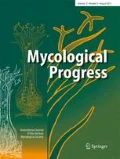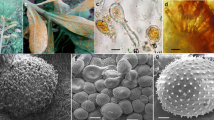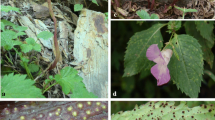Abstract
White blister rust is one of the most common diseases in Brassicaceae. Recently, molecular approaches revealed that apart from Albugo candida, several other more specialized species of the genus are causing this disease on Brassicaceae and the diversity of this group still remains largely unexplored. All newly described species have so far been sampled only from a limited geographic range, except for Albugo species which followed their invasive host from Europe to other continents. In this study we show that a previously unknown species of Albugo is causing white blister rust disease on two species of Strigosella. This species can be distinguished from other species of the genus Albugo both by its phylogenetic position and its unique oospore ornamentation that might be an adaptation to the harsh environment of the host plants. As a consequence, Albugo arenosa is described and illustrated as a new species, so far known from Strigosella africana in Iran and Spain, and Strigosella brevipes in Iran. Apart from Albugo candida and Albugo lepidii, this is the third hitherto known species of Albugo s. str. with a confirmed native distribution range of several thousand kilometres.


Similar content being viewed by others
References
Akhani H (2003) Notes on the flora of Iran: 4. two new records and synopsis of the new data on Iranian Cruciferae since Flora Iranica. Candollea 58:369–385
Bachofer M (2004) Molekularbiologische Populationsstudien an Plasmopara halstedii, dem Falschen Mehltau der Sonnenblume, Dissertation, Stuttgart, Germany
Biga MLB (1955) Riesaminazione delle specie del genere Albugo in base alle morfologia dei conidi. Sydowia 9:339–358
Choi D, Priest MJ (1995) A key to the genus Albugo. Mycotaxon 53:261–272
Choi Y-J, Thines M (2011) Morphological and molecular confirmation of Albugo resedae (Albuginales; Oomycota) as a distinct species from A. candida. Mycol Prog 10:143–148
Choi YJ, Hong SB, Shin HD (2006) Genetic diversity within the Albugo candida complex (Peronosporales, Oomycota) inferred from phylogenetic analysis of ITS rDNA and COX2 mtDNA sequences. Mol Phylogenet Evol 40:400–409
Choi YJ, Shin HD, Hong SB, Thines M (2007) Morphological and molecular discrimination among Albugo candida materials infecting Capsella bursa-pastoris worldwide. Fungal Divers 27:11–34
Choi YJ, Shin HD, Ploch S, Thines M (2008) Evidence for uncharted biodiversity in the Albugo candida complex, with the description of a new species. Mycol Res 112:1327–1334
Choi YJ, Shin HD, Thines M (2009) The host range of Albugo candida extends from Brassicaceae through Cleomaceae to Capparaceae. Mycol Prog 8:329–335
Choi YJ, Thines M, Shin HD (2011a) A new perspective on the evolution of white blister rusts: Albugo s.str. (Albuginales; Oomycota) is not restricted to Brassicales but also present on Fabales. Organ Divers Evol 11:193–199
Choi Y-J, Shin H-D, Ploch S, Thines M (2011b) Three new phylogenetic lineages are the closest relatives of the widespread species Albugo candida. Fungal Biol 115:598–607
Cooke DEL, Drenth A, Duncan JM, Wagels G, Brasier M (2000) A molecular phylogeny of Phytophthora and related Oomycetes. Fungal Gen Biol 30:17–32
Farr DF, Rossman AY (2012) Fungal databases, systematic mycology and microbiology laboratory, ARS, USDA. Retrieved February 17, 2012, from http://nt.ars-grin.gov/fungaldatabases
Garcia-Blazquez G, Constantinescu O, Telleria MT, Martin MP (2007) Preliminary check list of Albuginales and Peronosporales (Chromista) reported from the Iberian Peninsula and Balearic islands. Mycotaxon 98:185–188
German DA, Wen-li C (2009) Notes on the family Brassicaceae in China. J Syst Evol 47:202–219
Hudspeth DSS, Nadler SA, Hudspeth MES (2000) A cox2 molecular phylogeny of the Peronosporomycetes. Mycologia 92:674–684
Hudspeth DS, Stenger DC, Hudspeth ME (2003) A cox2 phylogenetic hypothesis for the downy mildews and white rusts. Fungal Divers 13:47–57
Huelsenbeck JP, Ronquist F (2001) MRBAYES: Bayesian inference of phylogenetic trees. Bioinformatics 17:754–755
Katoh K, Toh H (2008) Improved accuracy of multiple ncRNA alignment by incorporating structural information into a MAFFT based framework. BMC Bioinform 9:212
Katoh K, Kuma K-I, Toh H, Miyata T (2005) MAFFT version 5: Improvement in accuracy of multiple sequence alignment. Nucleic Acids Res 33:511–518
Khosravi AR, Mohsenzadeh S, Mummenhoff K (2009) Phylogenetic relationships of old world Brassicaceae from Iran based on nuclear ribosomal DNA sequences. Biochem Sys Ecol 37:106–115
Lysak MA, Koch M (2011) Phylogeny, genome and karyotype evolution of crucifers (Brassicaceae). Gen Genom Brassicaceae 9:1–31
Man In’t Veld WA, Rosendahl KC, de Cock AW (2011) Phytophthora gemini sp. nov., a new species isolated from the halophilic plant Zostera marina in the Netherlands. Fungal Biol 115:724–732
Melchers LE (1931) A check list of plant disease and fungi occurring in Egypt. Trans Kans Acad Sci 34:41–106
Mirzaee MR, Khodaparast A, Sajedi S, Javadi B, Saberi MH (2010) Malcolmia africana, a new host for powdery mildew disease caused by Erysiphe cruciferarum in Iran. Austral Plant Dis Notes 5:101–102
Moncalvo JM, Wang HH, Hseu RS (1995) Phylogenetic relationships in Ganoderma inferred from the internal transcribed spacer and 25S ribosomal DNA sequences. Mycologia 87:223–238
Novotel’nova NS, Pystina KA (1985) Ordo Peronosporales (Fam. Pythiaceae, Phytophthoraceae, Peronosporeaceae, Cystopaceae). In: Gorlenko MV (ed) Cryptogamic Flora of USSR. Fungi (3), vol 11. Nauka, Leningrad, USSR
Ploch S, Thines M (2011) Obligate biotrophic pathogens of the genus Albugo are widespread as asymptomatic endophytes in natural populations of Brassicaceae. Mol Ecol 20:3692–3699
Ploch S, Choi YJ, Rost C, Shin HD, Schilling E, Thines M (2010) Evolution of diversity in Albugo is driven by high host specificity and multiple speciation events on closely related Brassicaceae. Mol Phylogenet Evol 57:812–820
Ploch S, Telle S, Choi YJ, Cunnington JH, Priest M, Rost C, Shin HD, Thines M (2011) The molecular phylogeny of the white blister rust genus Pustula reveals a case of underestimated biodiversity with several undescribed species on ornamentals and crop plants. Fungal Biol 115:214–219
Riethmüller A, Voglmayr H, Göker M, Weiß M, Oberwinkler F (2002) Phylogenetic relationships of the downy mildews (Peronosporales) and related groups based on nuclear large subunit ribosomal DNA sequences. Mycologia 94:834–849
Ronquist F, Huelsenbeck JP (2003) MrBayes 3: Bayesian phylogenetic inference under mixed models. Bioinformatics 19:1572–1574
Shu SJ (2001) Malcolmia. Flora of China 8:154–156
Stamatakis A (2006) RAxML-VI-HPC: maximum likelihood-based phylogenetic analyses with thousands of taxa and mixed models. Bioinformatics 22:2688–2690
Stamatakis A, Hoover P, Rougemont J (2008) A rapid bootstrap algorithm for the RAxML web-servers. Syst Biol 75:758–771
Tamura K, Peterson D, Peterson N, Stecher G, Nei M, Kumar S (2011) MEGA5: molecular evolutionary genetics analysis using maximum likelihood, evolutionary distance, and maximum parsimony methods. Mol Biol Evol 28:2731–2739
Telle S, Thines M (2008) Amplification of cox2 ( 620 bp) from 2 mg of up to 129 years old herbarium specimens, comparing 19 extraction methods and 15 polymerases. PLoS One 3:e3584
Thines M, Spring O (2005) A revision of Albugo (Chromista, Peronosporomycetes). Mycotaxon 92:443–458
Thines M, Voglmayr H (2009) An introduction to the white blister rusts (Albuginaceae) In: Lamour K, Kamoun S (eds) Oomycete genetics and genomics: biology, interactions with plants and animals, and toolbox. Wiley-Blackwell, pp 77–92
Thines M, Göker M, Telle S, Ryley M, Mathur K, Narayana YD, Spring O, Thakur RP (2008) Phylogenetic relationships of graminicolous downy mildews based on cox2 sequence data. Mycol Res 112:345–351
Thines M, Choi YJ, Kemen E, Ploch S, Holub EB, Shin HD, Jones JDG (2009a) A new species of Albugo parasitic to Arabidopsis thaliana reveals new evolutionary patterns in white blister rusts (Albuginaceae). Persoonia 22:123–128
Thines M, Voglmayr H, Göker M (2009b) Taxonomy and phylogeny of the downy mildews (Peronosporaceae). In: Lamour K, Kamoun S (eds) Oomycete genetics and genomics: Biology, interactions with plants and animals, and toolbox. Wiley-Blackwell, pp. 47–75
Ul’yanishchev VI, Osipian LL, Kanchaveli LA, Akhundov TM (1985) Peronosporovye Griby. In: Ul’yanishchev VI (ed) Opredelitel’ gribov Zakavkaz’ya. Ere van University, Erevan
Voglmayr H, Riethmüller A (2006) Phylogenetic relationships of Albugo species (white blister rusts) based on LSU rDNA sequence and oospore data. Mycol Res 110:75–85
Warwick SI, Francis A, Al-Shehbaz IA (2006) Brassicaceae. species checklist and database on CD-Rom. Pl Syst Evol 259:249–258
Warwick SI, Sauder C, Al-Shehbaz IA, Jacquemoud F (2007) Phylogenetic relationships in the tribes Anchonieae, Chorisporeae, Euclidieae, and Hesperideae (Brassicaceae) based on nuclear ribosomal ITS DNA sequences. Ann Mo Bot Gard 94:56–78
Wilson GW (1907) Studies in North American Peronosporales-I. The genus Albugo. Bull Torrey Bot Club 34:61–84
Acknowledgments
The present study was supported by the research funding programme “LOEWE – Landes-Offensive zur Entwicklung Wissenschaftlich-ökonomischer Exzellenz” of Hesse’s Ministry of Higher Education, Research, and the Arts. Author contributions – FR, MRM, MT collected pathogen material, MT designed the study, LN, MRM, SP and ST conducted experiments, MRM performed microscopic investigations, SP performed phylogenetic inferences, MRM, MT, and SP analysed the data, FR, MRM, MT, and SP wrote the manuscript. One anonymous referee is gratefully acknowledged for providing an excellent and detailed review of the manuscript.
Author information
Authors and Affiliations
Corresponding author
Rights and permissions
About this article
Cite this article
Mirzaee, M.R., Ploch, S., Runge, F. et al. A new presumably widespread species of Albugo parasitic to Strigosella spp. (Brassicaceae). Mycol Progress 12, 45–52 (2013). https://doi.org/10.1007/s11557-012-0811-4
Received:
Revised:
Accepted:
Published:
Issue Date:
DOI: https://doi.org/10.1007/s11557-012-0811-4




